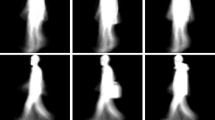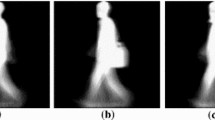Abstract
Automated authentication systems are currently the research trend, as security is given utmost importance. Biometric systems are considered reliable; however, they demand human intervention or cooperation for data collection. On the contrary, gait represents the walking pattern of an individual, which is unique, and it does not require human intervention. However, gait authentication systems are confronted by numerous challenges such as illumination, different angles and poor lighting condition. This article presents a gait authentication scheme, which is based on grey wolf optimization algorithm-optimized Gabor features. The potential features are then selected by information gain ratio, and the kernelized extreme learning machine is employed for authentication. The proposed scheme is analysed with respect to recognition accuracy, precision, recall, F1-score and time consumption against existing approaches, where the results show that the proposed scheme performs better.





Similar content being viewed by others
Data availability
Enquiries about data availability should be directed to the authors.
References
Aggarwal H, Vishwakarma D (2017) Covariate conscious approach for gait recognition based upon zernike moment invariants. IEEE Trans Cogn Dev Syst 1(99):1–1
Altan A, Karasu S, Zio E (2021) A new hybrid model for wind speed forecasting combining long short-term memory neural network, decomposition methods and grey wolf optimizer. Appl Soft Comput. https://doi.org/10.1016/j.asoc.2020.106996
Boulgouris N, Huang X (2013) Gait recognition using HMMs and dual discriminative observations for sub-dynamics analysis. IEEE Trans Image Process 22(09):3636–3647
Connie T, Goh M, Teoh A (2017) A grassmannian approach to address view change problem in gait recognition. IEEE Trans Cybern 47(06):1395–1408
Guan Y, Li C, Roli F (2015) On reducing the effect of covariate factors in gait recognition: a classifier ensemble method. IEEE Trans Pattern Anal Mach Intell 37(07):1521–1529
Han J, Bhanu B (2006) Individual recognition using gait energy image. IEEE Trans Pattern Anal Mach Intell 28(2):316–322
Huang X, Boulgouris N (2012) Gait recognition with shifted energy image and structural feature extraction. IEEE Trans Image Process 21(04):2256–2268
Huang G-B, Zhou H, Ding X, Zhang R (2012) Extreme learning machine for regression and multiclass classification. IEEE Trans Syst, Man Cybern - Part B 42(2):513–529
Islam M, Islam M, Hossain M, Ferworn A, Molla M (2017) Subband entropy-based features for clothing invariant human gait recognition. Adv Robot 31(10):519–530
Khamsemanan N, Nattee C, Jianwattanapaisarn N (2017) Human identification from freestyle walks using posture-based gait feature. IEEE Trans Inf Forensics Secur 13:119–128
Kusakunniran W, Wu Q, Zhang J, Li H (2012) Gait recognition across various walking speeds using higher order shape configuration based on a differential composition model. IEEE Trans Syst Man Cybern Part B (cybernetics) 42(6):1654–1668
Lai Z, Xu Y, Jin Z, Zhang D (2014) Human gait recognition via sparse discriminant projection learning. IEEE Trans Circuits Syst Video Technol 24(10):1651–1662
LeCun Y, Bengio Y, Hinton G (2015) Deep learning. Nature 521(5):436–445
Makihara D, Yasushi Y (2016) View transformation model incorporating quality measures for cross-view gait recognition. IEEE Trans Cybern 47(07):1602–1615
Malik MN, Azam MA, Ehatisham-Ul-Haq M, Ejaz W, Khalid A (2019) ADLAuth: Passive authentication based on activity of daily living using heterogeneous sensing in smart cities. Sensors 19:2466
Mirjalili S, Mirjalili SM, Lewis A (2014) Grey wolf optimizer. Adv Eng Softw 69:46–61
Muramatsu D, Makihara Y, Yagi Y (2015) Cross-view gait recognition by fusion of multiple transformation consistency measures. IET Biom 4(2):62–73
Rida I, Jiang X, Marcialis GL (2016) Human body part selection by group lasso of motion for model-free gait recognition. IEEE Signal Process Lett 23(01):154–159
Tafazzoli F, Safabakhsh R (2010) Model-based human gait recognition using leg and arm movements. Eng Appl Artif Intell 23(8):1237–1246
Takemura N, Makihara Y, Muramatsu D, Echigo T, Yagi Y (2018) On input/output architectures for convolutional neural network-based cross-view gait recognition. IEEE Trans Circuits Syst Video Technol 28(1):316–322
Theekhanont P, Kurutach W, Miguet S (2012) Gait recognition using GEI and pattern trace transform. In: International Symposium on Information Technologies in Medicine and Education, pp 936–940
Wan C, Wang L, Phoha VV (2018) A survey on gait recognition. ACM Comput Surv 51:1–35
Wang L, Tan T, Ning H, Hu W (2003) Silhouette analysis-based gait recognition for human identification. IEEE Trans Pattern Anal Mach Intell 25(12):1505–1518
Wang X, Wang J, Yan K (2018) Gait recognition based on Gabor wavelets and (2D)2PCA. Multimed Tools Appl 77(10):12545–12561
Wu Z, Huang Y, Wang L, Wang X, Tan T (2017) A comprehensive study on cross-view gait based human identification with deep CNNs. IEEE Trans Pattern Anal Mach Intell 39(02):209–226
Yu S, Tan D, Tan T (2006) A framework for evaluating the effect of view angle, clothing and carrying condition on gait recognition. In: 18th international conference on pattern recognition, 2006. ICPR 2006
Zhang H, Ji Y, Huang W, Liu L (2018) Sitcom-star-based clothing retrieval for video advertising: a deep learning framework. Neural Comput Appl 1(1):1–20
Zhang C, Liu W, Ma H, Fu H (2016) Siamese neural network based gait recognition for human identification. In: IEEE international conference on acoustics, speech and signal processing, pp 2832–2836
Funding
None.
Author information
Authors and Affiliations
Contributions
All authors contributed to the study conception and design. Material preparation, data collection and analysis were performed by Ms. Ambika K. The first draft of the manuscript was written by Ms. Ambika K., and the supervisor has assisted on the preparation of the manuscript. All authors read and approved the final manuscript.
Corresponding author
Ethics declarations
Conflict of interest
The authors have no conflicts of interest.
Additional information
Publisher's Note
Springer Nature remains neutral with regard to jurisdictional claims in published maps and institutional affiliations.
Rights and permissions
Springer Nature or its licensor (e.g. a society or other partner) holds exclusive rights to this article under a publishing agreement with the author(s) or other rightsholder(s); author self-archiving of the accepted manuscript version of this article is solely governed by the terms of such publishing agreement and applicable law.
About this article
Cite this article
Ambika, K., Radhika, K.R. Model-free supervised learning-based gait authentication scheme based on optimized gabor features. Soft Comput 27, 5053–5062 (2023). https://doi.org/10.1007/s00500-023-08029-8
Accepted:
Published:
Issue Date:
DOI: https://doi.org/10.1007/s00500-023-08029-8




